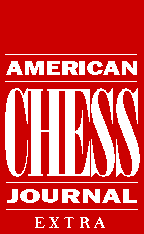
Endgame Explorations 3: Domination
Noam Elkies
As promised last time, we turn in the present column to the domination theme: the surprising entrapment of an apparently invulnerable piece. A well-known Fischer combination provides a good example from practical play:
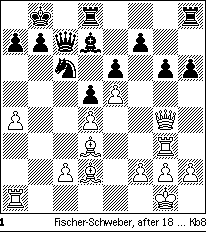
Schweber's last move, 18 ... Kb8, was a subtle error that gave Fischer a unique opportunity to exploit the placement of Black's royalty on the same diagonal:
19 Rf3! f5? 20 exf6! e5 21 Qg3 Nxd4
Of course not 21 ... e4?? 22 Bf4, but Black still seems fine.
22 Re3 e4 23 Rxe4!! Qxg3
Has Fischer blundered a rook to this simple zwischenzug?
24 Rxd4!!
An amusing echo to Marshall's "gold-shower" combination. The queen is trapped! Schweber did the best he could by getting a rook for it.
24 ... Qg4
If 24 ... Qe5 (or 24 ... Qd6 or 24 ... Qc7), then 25 Bf4 again reveals the weakness created by Black's 18th move.
25 Rxg4 Bxg4 26 Bxg6
Fischer now had a second pawn for the exchange and a won endgame.
The domination theme becomes even more attractive in composed endgames, where control of all the squares at the trapped piece's disposal requires great economy of force. Observe the following endgame, in which D. Petrov employs a mechanism akin to that of Fischer's combination from Diagram 1:
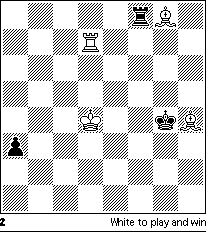
This miniature won First Prize in the 1958-59 Chigorin Memorial Tourney.
Without pawns White cannot afford to lose either of his attacked bishops,
so:
1 Rd8! a2!
To disrupt White's fragile protection of his bishops.
2 Bxa2 Rf4+! 3 Ke3! Ra4 4 Bb3 Rb4
4 ... Ra3 5 Rd4+ and 6 Rb4 wins.
5 Rd4+!
What's the point? Must White not lose a bishop anyhow?
5 ... Rxd4 6 Be7!!
And White wins, since incredibly, the rook has been trapped (6 ... Rf4 7 Be6+ Rf5 8 Ke3) on an open board by only a king and two bishops!
Naturally the queen is the hardest piece to dominate. The indefatigable Troitsky (some 300 of whose endgames appear in Kasparyan's Domination in 2545 Endgame Studies) has constructed many beautiful queen dominations, including the following position (from Trudovaya Pravda, 1927) where none of the 24 squares available to the Black queen protect it from White's cavalry:
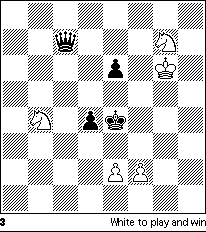
The queen is curiously helpless after 1 Ne8, since of the squares not directly controlled by White's pieces, c4, b7, d7, and c8 are covered by an immediate 2 Nd6(f6) fork; c1, h2, f4, a5, c5, e5, b6, a7, e7, b8, and d8 allow a fork
after 2 Nf6+ Ke5 (2 ... Kf4? 3 Nd3#); and the remaining 1 ... Qc3 succumbs at the fourth move after 2 Nf6+ Ke5 3 Nd3+ Kd6 4 Ne4+.
And finally Kasparyan's First Prize endgame in the 1960 Revista de Sah tourney:
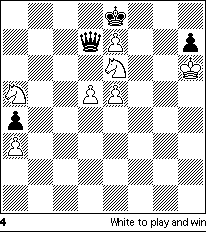
1 Nc4! Qxe7
1 ... Ke7 2 Nd6 Qa7 3 Nc8, 1 ... Qxd5? 2 Nc7+, and other queen moves lose more quickly to 2 Nd6+.
2 Nxd6+ Kd7
Looks familiar, but now White must prevent Qh4+.
3 Kh5 h6 4 Kg4 h5+ 5 Kg3!
Not 5 Kxh5 Qh7+.
5 ... h4+ 6 Kh3 Qh7 7 Nf8+.
Here again two knights trapped the queen. But note that, unlike the queens and rook Dominated in Diagrams 1-3, the Black queen in Diagram 4 was not attacked, falling instead to zugzwang---more precisely, simple zugzwang in the 1 ... Ke7 line, mutual zugzwang in the 1 ... Qe7 line, about both of which more in future columns.
Noam Elkies is now Professor of Mathematics at Harvard University and is the author of "Chess Art in the Computer Age," published in ACJ 2 (1993). This article originally appeared in Chess Horizons.Next column: Zugzwang (Part 1).
This page last modified on
28 April 2018.
Copyright (c) 1995-2018 Christopher F. Chabris. All rights
reserved.




